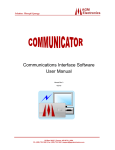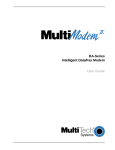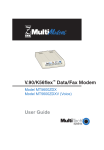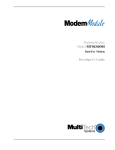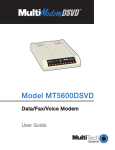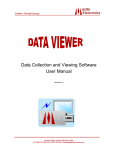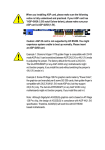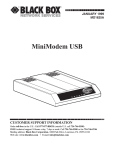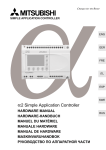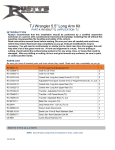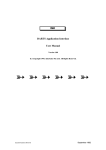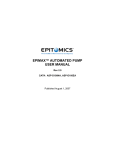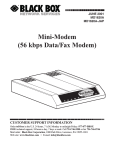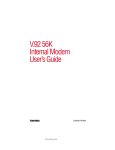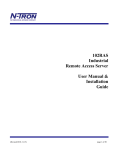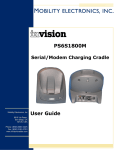Download Dial-Up / Leased-Line Modem
Transcript
AGM Electronics, Inc – Dial-Up / Leased-Line Modem, Series ( ) 5019-1 Manual Rev A User Manual CD + - CTS RTS DTR DSR . RI RX TX PHONE LINE DLM Dial-Up / Leased-Line Modem Dial-Up / Leased-Line Modem CONTENTS INTRODUCTION ........................................................................................................................................................... 1 Overview.................................................................................................................................................................. 2 Theory of Operation and Construction .............................................................................................................. 2 General Specifications .......................................................................................................................................... 4 HARDWARE INSTALLATION..................................................................................................................................... 5 TELEPHONE CONNECTION ................................................................................................................................... 5 LEASED-LINE CONNECTION ................................................................................................................................. 5 POWER CONNECTION ............................................................................................................................................ 5 CONNECTING TO A PERSONAL COMPUTER..................................................................................................... 6 CONNECTING TO AGM DATA HANDLER (DH) RS232....................................................................................... 7 CONNECTING TO AGM INTEGRATED CONTROL STATION (ICS) .................................................................. 7 CONNECTING TO AGM UNIVERSAL WEB STATION (UWS) ............................................................................ 8 CONNECTING TO A 3RD PARTY PLC..................................................................................................................... 8 GETTING STARTED .................................................................................................................................................... 9 SETTING DLM FOR DIAL-UP OPERATION........................................................................................................... 9 SETTING DLM FOR LEASED-LINE OPERATION............................................................................................... 11 CONFIGURATION ...................................................................................................................................................... 13 ENTERING COMMAND MODE.............................................................................................................................. 13 COMMON COMMANDS.......................................................................................................................................... 14 Answer (A)............................................................................................................................................................. 14 Dial (D).................................................................................................................................................................... 14 Echo Character (E)............................................................................................................................................... 14 Hang Up (H0)......................................................................................................................................................... 14 Monitor Speaker (M) ............................................................................................................................................ 14 Result Codes Enable (Q)..................................................................................................................................... 14 Result Codes Format (V)..................................................................................................................................... 14 Carrier Detect (&C)............................................................................................................................................... 14 Data Terminal Ready DTR Control (&D) ........................................................................................................... 15 Load Factory Settings (&F0) .............................................................................................................................. 15 Flow Control (&K)................................................................................................................................................. 15 Leased-Line (&L) .................................................................................................................................................. 15 NOTE: For Leased-Line operation one DLM must be set for Originate and the other must be set for Answer. 15 DSR Control (&S) ................................................................................................................................................. 15 Display Configuration Settings (&V)................................................................................................................. 15 Save Changes (&W0)........................................................................................................................................... 15 AT Command Control (%DC)............................................................................................................................. 15 Inactivity Timer (\T) .............................................................................................................................................. 16 Data Format ($EB) and (#P)................................................................................................................................ 16 Serial Port Baud Rate ($SB) ............................................................................................................................... 16 MODULATION COMMANDS.................................................................................................................................. 17 Modulation Selection (+MS=) ............................................................................................................................. 17 Display Modulation Selection (+MS?)............................................................................................................... 17 Error Control (&Q)................................................................................................................................................ 17 S REGISTERS.......................................................................................................................................................... 18 Dialup / Leased Line Modem TECHNICAL SUPPORT .............................................................................................................................................19 DIAGNOSTICS AND TROUBLE SHOOTING ..........................................................................................................20 INDICATOR LIGHTS................................................................................................................................................20 TROUBLESHOOTING HINTS.................................................................................................................................20 Loss of Connection / Failure to Connect..........................................................................................................20 Failure to Disconnect on Dial-Up Connections...............................................................................................23 Failure to Disconnect on Loss of Carrier .........................................................................................................24 DLM Tries to Connect Immediately on a Dial-Up Phone Line.......................................................................24 APPENDIX A................................................................................................................................................................25 WIRING AND SIMPLIFIED DIAGRAM...................................................................................................................25 Dialup / Leased Line Modem Introduction Introduction Thank you for purchasing the AGM Dial-Up / Leased-Line Modem (DLM). The AGM Dial-Up / Leased-Line Modem provide a variety of cost effective data communication possibilities. This manual covers installation and setup of the more commonly used configurations. Screw Terminal Connections Pin 1 2 Description Power (+) Power (-) Carrier Detect Indicator CTS Indicator RTS Indicator DTR Indicator RS232 Connector (Female) DSR Indicator Ring Indicator Monitoring Speaker Phone Line Connection (RJ11) 1 Dialup / Leased Line Modem Introduction Overview The AGM AUX/DIN 5019-1 DLM is a low cost V.92 modem which supports Leased-Line as well as Dial-Up connections. The DLM complies with FCC and other international regulations for connection to public telephone systems. The DLM may also be used over a dry metallic pair of lines. The DLM is for use with RS232 system. The standard DLM communicates using the V.92 modem standard and is backwards compatible with earlier modem standards. It is configured using the AT command set common with most commercial Dial-Up modems found in desktop and laptop computers. The default configuration of the DLM will automatically detect the correct data communications rate however the DLM can be set to use a specific rate such as 9600 bps if required. Fixing the communications data rate can eliminate some connection problems when communication conditions are not optimal. Theory of Operation and Construction The heart of the DLM is an industrial hardened V.92 modem that integrates most of the common error correcting and data compression algorithms found in many commercial modems such as those found in your desktop or laptop computer. Unlike the modem found in your desktop, the DLM also incorporates a Leased-Line feature which allows the DLM to be used over a Leased-Line from the phone company or via a dry metallic pair of wires. The DLM may be used with any protocol that uses 7 or 8 bit asynchronous data. This includes but is not limited to: ASCII Modbus, RTU Modbus, DF1, or DNP3. You do not need to own AGM Electronics Inc. equipment to use the DLM. The DLM is configured by using a computer and any terminal emulation software such as AGM’s SCADA, AGM’s Communicator or Hyper Terminal which is packaged with Microsoft Windows. The DLM may be configured in the field using a laptop computer and RS232 cable. When used for a Dial-Up connection the DLM acts like any external Dial-Up modem that you may have connected to your computer. When the DLM receives a dial command “EG ATD123-4567” the DLM will go off hook, check for a dial tone and then dial the number. When the receiving DLM or modem detects a ring on the phone line, the modem answers then emits a tone. When the originating DLM detects the tone from the answering modem the two modems will then attempt to negotiate a connection rate. Once the data rate has been negotiated the CD light will be turned on and if enabled a connect message will be sent to each of the connected devices. When used in the Dial-Up configuration the DLM is compatible with most other commercial modems that adhere to one of the supported standards. Dialup / Leased Line Modem 2 Introduction When used with a Leased-Line connection one DLM must be set up to “originate” and the other to “answer”. After approximately 30 seconds after power up one DLM will start emitting a tone and the other DLM will listen for the tone. Once the tone is detected the two DLM’s will negotiate a connection as in a Dial-Up connection. NOTE: In Leased-Line mode the AGM Electronics DLM is only compatible with another AGM Electronics DLM. Connection to other Leased-Line modems is not supported. Also, multi-drop connections are not supported. When you order your DLM indicate how you would like to have the DLM configured. AGM Electronics Inc. will configure your DLM at the factory free of charge. The hermetically sealed assembly minimizes installation costs. 3 Dialup / Leased Line Modem Introduction General Specifications Connections – 1 RS232C; Power; RJ-11 Telephone Company Baud Rate – 0 – 300; 1200; 2400; 4800; 7200; 9600, 12,000; 14,400; 19,200; 21,600; 24,000; 26,400; 28,800; 31,200; 33,600 bps Data Compatibility – V.92; V.34 enhanced; V.34; V.32bis; V.32; V.22bis; V.22; Bell 212A and 103/113; V.21 and V.23 Data Compression – ITU-T V.44; V.42.bis; MNP 5 Error Correction – V.42 Status Indicators – 8 Operating Temperature Range, -20/80 deg C Adjustments – Operator configurable locally from a PC Power – 11/30 VDC +/- 10%, nominal 2.5 Watts Physical – 3 X 1.4 X 3.5 (DIN), 3 X 1.4 X 2.7 (AUX) Safety Certifications – UL60950; cUL60950; EN60950; IEC6090; ACA TS001 / AS 3260 EMC Certifications – FCC Part 15; Canadian EMC; EN 55022; EN 55024; GB4943; GB9254 Registration No – AU7USA-25814-M5-E Ringer Equivalence – 0.3B Dialup / Leased Line Modem 4 Hardware Installation Hardware Installation The DLM is available pre-configured to your application. When pre-configured, the DLM is ready for use and you only need to connect your equipment. If not pre-configured or if you need to modify the configuration you will need to connect the DLM to a computer containing a RS232 serial port and terminal emulation program. Hyper Terminal is available on any Microsoft Windows 95/98/NT/2000/XP system. Telephone Connection The telephone line connector on the DLM is a standard RJ-11 telephone jack. Use a standard telephone modular cable to connect between the DLM and the RJ-11 telephone jack supplied by the telephone company. NOTE: The DLM should only be plugged into a standard telephone line or dry metallic pair of lines. Some digital telephone and other systems may also use a RJ-11 jack for connecting their digital phones. The DLM is not compatible with these types of systems and plugging the DLM into one of these systems may result in damage to the DLM and phone system. Leased-Line Connection The DLM uses the same RJ-11 jack for connecting Leased-Lines as well as standard Dial-Up lines. The DLM will operate with a dry metallic pair of lines. Connect the dry pair to a modular RJ-11 plug or jack then plug the dry pair into the DLM’s RJ-11 jack. Use the two center connections of the RJ-11. The phone lines used by the DLM are not polarized. Power Connection The DLM will operate from either a 12 VDC or 24 VDC supply system that is capable of supplying 300 mA. Connect the positive lead of your power supply to pin 1 of the connector and the negative lead to pin 2 of the connector. Should you ever be required to remove the DLM you may un-plug the connector by lifting straight up from the body of the DLM. You do not need to remove the power wires once installed. When power is applied the “DSR” light should turn on immediately followed by the “CTS” no more than one second later. Until you connect up your computer, PLC or other RS232 device these are the only two lights that will be on. 5 Dialup / Leased Line Modem Hardware Installation Connecting to a Personal Computer Use the following procedure to connect the DLM to your computer for either configuration changes or use. You will need a “straight-through” cable to connect to the DLM. This cable should have a 9 or 25 pin female connector on one end to match the connector on you computer and a 9 pin male connector on the other end to mate with the DLM. Cables, adapters and gender changers designed for connecting a computer to a modem are available through many computer, electronic or office supply stores. The DLM also supports RS232 using only 3 wires, Transmit, Receive and Ground. Typically 3 wire RS232 is only used with custom cables to reduce the wiring cost. If using 3 wire RS232 you will need to disable DTR detection and hardware handshaking by configuring the DLM with “AT&K0&D0&W0” command. These changes are done via configuration commands entered while connected to the DLM. You may need to initially connect to the DLM using a standard RS232 cable or order your DLM preconfigured for 3 wire operation. NOTE: While using the DLM with only 3 RS232 wires the “RTS” and “DTR” lights will remain off. You will also not be able to use hardware handshaking or be able to hang up the phone line by toggling the “DTR” line. Make sure any connected hardware does not require the use of these lines. 1. Plug one end of the RS232 cable into an available RS232 communications port your PC. This port is normally a 9 pin male D connector; however it may also be a 25 pin D connector in some cases. Consult with your PC documentation for the location of this connector. 2. Plug the other end of the RS232 cable from your PC into the 9 pin female D connectors on the top of the DLM. 3. Start Hyper Terminal or other terminal emulator program. Select direct connect to the serial port connected to the DLM. Unless configured for another baud rate or data format, select 9600 bps (baud), 8 data bits, no parity, and 1 stop bit. If connecting for configuration, turn off all handshaking. If properly connected and not using a 3 wire connection the “CTS”, “RTS”, “DTR” and “DSR” lights should be on. If not on check your cable connections and RS232 port on your computer. If using 3 wire RS232 the “RTS” or “DTR” lights will be off. You can only test a 3 wire RS232 connection by observing the “TX” light on the DLM and typing keys on your keyboard while connected to the DLM. 4. Cycle the power and wait for the “CTS” and “DSR” lights to turn on. Then within 10 seconds type “ATi” followed by a carriage return (Enter key) in your terminal emulator program. If properly connected you should see a text response on your screen. The “TX” light should flash when you are typing. The “RX” light may flash when you type a key or just after you press the carriage return key (Enter key). Dialup / Leased Line Modem 6 Hardware Installation NOTE: In some cases you can simply check the connection by entering just the “AT” command and watching for “AT” to be echoed followed by “OK”. The echoing of command characters as well as the response codes can be disabled so simply entering “AT” will not work. Also when used in the Leased-Line mode the DLM will only accept commands within the first 10 seconds after power up. Following the above procedure of cycling the power then entering “ATi” will work in all cases. Connecting to AGM Data Handler (DH) RS232 To connect a DLM to a RS232 Data Handler you will need a 9 pin female to 9 pin male nullmodem cable. 1. Plug one end of the RS232 cable into the 9 pin male connector on the Data Handler. 2. Plug the other end of the RS232 cable into the 9 pin female D connector on top of the DLM. 3. Power up both the Data Handler and DLM. If properly connected the “DTR”, “DSR”, “CTS” and “RTS” lights should be on. If “RTS” light is off the Data Handler may be configured for half-duplex operation you may either turn off the half-duplex in the Data Handler or disable the hardware handshaking in the DLM. Hardware handshaking may be disabled by connecting the DLM to a computer then entering “AT&K0&W0”. Connecting to AGM Integrated Control Station (ICS) To connect a DLM to an ICS you will need a 9 pin male to 25 pin female straight through cable. 1. Plug the 25 pin end of the cable of the RS232 cable into the 25 pin D connector on the back of the ICS. 2. Plug the other end of the RS232 cable into the 9 pin female D connector on top of the DLM. 3. Power up both the ICS and DLM. If properly configured the “DTR”, “DSR”, “CTS”, and “RTS” lights should be on. If these lights are not on check your cable connections. 7 Dialup / Leased Line Modem Hardware Installation Connecting to AGM Universal Web Station (UWS) To connect a DLM to a UWS Data Handler you will need a 9 pin female to 9 pin male straight through cable. 1. Plug one end of the RS232 cable into one of the 9 pin male connectors on the UWS. Select either “A” or “B” depending on which port will be used with the DLM. 2. Plug the other end of the RS232 cable into the 9 pin female D connector on top of the DLM. 3. Power up both the UWS and DLM. If properly configured the “DTR”, “DSR”, “CTS”, and “RTS” lights should be on. If these lights are not on check your cable connections. Connecting to a 3rd Party PLC The DLM supports any PLC that uses a protocol based on 7 or 8 data bit asynchronous serial communications. This includes ASCII Modbus, RTU Modbus, Allen-Bradley DF1 Half Duplex and DNP3 protocols. You must have the appropriate RS232 interface installed. Consult with your PLC manufacture on the RS232 interface to use. You will need a cable to connect from your PLC to a Modem. If a cable of this type is not available you will need a Null-Modem adapter and possibly a gender changer to connect your PLC to the DLM. Null-Modem adapters and gender changers are typically available through many computer, electronic or office supply stores. 1. Plug one end of the RS232 cable into your PLC. See your PLC documentation for making this connection. 2. Plug the other end of the RS232 cable from the PLC into the 9 pin female D connector on the top of the DLM. 3. Power up both the DLM and PLC. If properly configured the “DTR”, “DSR”, “CTS”, and “RTS” lights should be on. Some PLC’s may not provide full hardware handshaking. These PLC’s may still be used with the DLM however you will need to disable the hardware handshaking and DTR control in the DLM. Hardware handshaking may be disabled by connecting the DLM to a computer then entering “AT&K0&W0”. DTR control may be disabled by connecting to a computer and entering “AT&D0&W0”. Dialup / Leased Line Modem 8 Getting Started Getting Started The DLM may be preconfigured at the factory. In this case your DLM should be ready to use after you have made all hardware connections. If not preconfigured the following two sections will provide instruction on configuring your DLM. See the Configuration Commands section for details on some of the available DLM configuration commands. To configure your DLM you will need to connect to a computer running Hyper Terminal or other terminal emulator program. See Connecting to Personal Computer section above for details on how to connect to your computer. Setting DLM for Dial-Up Operation The basic configuration for Dial-Up operation is the same whether the DLM will be dialing out or answering. Each of the following commands will be entered then followed with a carriage return (Enter Key). After entering each command wait for the “OK” response. 1. Turn on the DLM and as soon as the “DSR” and “CTS” lights turn on enter: AT%DC0 NOTE 1: You may not get a response from this command. Some configurations disable the response to commands as well as the echoing of characters. NOTE 2: It is possible to set up the DLM to ignore any commands. To break out of this mode the “%DC0” command must be sent within the first 10 seconds after power up. 2. Reset the DLM to its factory defaults by entering: AT&F0 NOTE 1: You will get an “OK” response from this command. NOTE 2: We recommend always restoring the DLM to factory defaults and reentering all settings in this procedure. This guarantees the DLM is in a known condition. 3. For connections other than to a computer where the data rate (Baud Rate) and data format can be determined from the “AT” command the DLM will need to be set to the correct data rate and data format. Depending on the data rate of your connection enter one of the following command strings: a. 19200 bps: AT$SB19200 b. 9600 bps: AT$SB9600 c. 1200 bps: AT$SB1200 d. 300 bps: AT$SB300 9 Dialup / Leased Line Modem Getting Started 4. Depending on the data format of your connection enter one of the following command strings: a. 8 data bits, no parity, 1 stop bit: AT$EB0 b. 8 data bits, even or odd parity, 1 stop bit: AT$EB1#P1 c. 8 data bits, no parity, 2 stop bits: AT$EB1#P2 d. 8 data bits, even or odd parity, 2 stop bits: AT$EB1#P0 e. 7 data bits, no parity, 1 stop bit: AT$EB0 f. 7 data bits, even or odd parity, 1 stop bit: AT$EB0 g. 7 data bits, no parity, 2 stop bits: AT$EB0 h. 7 data bits, even or odd parity, 2 stop bits: AT$EB1#P0 5. If using 3 wire RS232 or if hardware handshaking is not supported enter: AT&K0 6. if using 3 wire RS232 or if DTR is not available form your device enter: AT&D0 7. Save settings: AT&W0 8. You are done configuring your DLM. You may test the configuration by dialing out to another modem or DLM or by dialing into the DLM. Dialup / Leased Line Modem 10 Getting Started Setting DLM for Leased-Line Operation When the DLM is used with a Leased-Line one DLM must be set up to “originate” the connections and the other DLM set up to “answer”. With the exception of the &L1 and &2 commands described in step 6 below the commands to set up the DLM will be the same. The following procedure will set up the DLM to automatically connect without any intervention from either connected device. You do not need to have any device connected to the RS232 port. Each of the following commands will be entered then followed with a carriage return (Enter Key). After entering each command wait for the “OK” response. 1. Turn on the DLM and as soon as the “DSR” and “CTS” lights turn on enter: AT%DC0 NOTE 1: You may not get a response from this command. The leased line configuration disables the response to commands as well as the echoing of characters. NOTE 2: When used with Leased-Lines the DLM will be set up to ignore any commands. To break out of this mode the “%DC0” command must be sent within the first 10 seconds after power up. 2. Reset the DLM to its factory defaults by entering: AT&F0 NOTE 1: You will get an “OK” response from this command. NOTE 2: We recommend always restoring the DLM to factory defaults and reentering all settings in this procedure. This guarantees the DLM is in a known condition. 3. Depending on the data rate of your connection enter one of the following command strings: a. 19200 bps: AT$SB19200+MS=V32B,0,0,19200,0,19200 b. 9600 bps: AT$SB9600+MS=V32,0,0,9600,0,9600 c. 1200 bps: AT$SB1200+MS=V22,0,0,1200,0,1200 d. 300 bps: AT$SB300+MS=V21,0,0,300,0,300 4. Depending on the data format of your connection enter one of the following command strings: a. 8 data bits, no parity, 1 stop bit: AT$EB0 b. 8 data bits, even or odd parity, 1 stop bit: AT$EB1#P1 c. 8 data bits, no parity, 2 stop bits: AT$EB1#P2 d. 8 data bits, even or odd parity, 2 stop bits: AT$EB1#P0 e. 7 data bits, no parity, 1 stop bit: AT$EB0 f. 7 data bits, even or odd parity, 1 stop bit: AT$EB0 g. 7 data bits, no parity, 2 stop bits: AT$EB0 h. 7 data bits, even or odd parity, 2 stop bits: AT$EB1#P0 11 Dialup / Leased Line Modem Getting Started 5. Set DTR control and Hardware handshaking. a. If hardware handshaking is not required enter: b. If hardware handshaking is required enter: AT&D0&K0 AT&D0&K1 6. Set the Leased-Line Mode: a. Originating DLM: AT&L1 b. Answering DLM: AT&L2 7. Set inactivity timer: The inactivity timer provides a failsafe in case communications is lost. When communications is lost the DLM will disconnect after the specified number of minutes then immediately attempt to reconnect. a. If communications will be continuous: AT\T1 b. If communications will be slower than 1 minute per data transfer but less 254 minutes enter: AT\Tn Where “n” is the data transfer rate in minutes plus 1. (EG If transfer rate is 5 minutes then enter “AT\T6”. 8. Disable echoing of characters and the displaying of result codes: NOTE: ATE0Q1 You will not get an “OK” response from this or the following command. Disabling the echoing of characters and displaying of result codes will prevent the DLM from interfering with the connected devices by introducing random characters into the data transferred. Leaving the result codes enabled will however provide information about the connection which can be useful for diagnosing connection problems. 9. Disable AT commands and save settings: AT%DC1&W0 10. You are done configuring your DLM. You may test the configuration by connecting two DLM’s together using a standard RJ-11 modular telephone cable. When set up for Lease Line operation you do not need a telephone line. The DLMs will connect on their own without any equipment connected to their RS232 ports. Dialup / Leased Line Modem 12 Configuration Configuration To modify the configuration of a DLM the following will be required: 1. Computer with an available RS232 “COM” port. 2. Terminal Emulator such as Hyper Terminal. 3. Straight through RS232 cable to connect your computer to the DLM. 4. 12 to 30 volt power supply. The DLM typically draws 170 mA @12 VDC. 5. The Dial-Up / Leased-Line Modem (DLM). The following instructions assume you are familiar with your terminal emulator program and how to connect the DLM to your computer. See the Hardware Installation section for instructions on connecting the DLM to your computer. The DLM uses “AT” commands like many internal and external modems used with computers. Like other modems some of the AT commands are standard while others are specific to the manufacture. All commands except the command to enter the command mode must be prefixed by “AT”. The following sections describe the commands you are most likely need to modify. A complete list is available from AGM Electronics Inc. Entering Command Mode When used with Dial-Up connections the escape character sequence of “+++” will switch form the data mode to the command mode. When used with Leased-Lines, the DLM has a 10 second window after power up during which the DLM will always respond to commands. There is also a 30 second delay between power up and when the DLM enters Leased-Line mode. Use the “%DC0” to allow commands beyond the first 10 seconds and “&L0” command to disable the Leased-Line mode. NOTE: 13 We recommend always restoring the DLM to factory defaults and reentering all settings in the Getting Started Section. This guarantees the DLM is in a known condition. The commands in this section are to provide a better understanding of the commands used for setting up the DLM and to provide information for advanced modem uses in setting up custom configurations. Dialup / Leased Line Modem Configuration Common Commands The following are the commands most commonly used in setting up your DLM. Answer (A) Enter “ATA” to immediately answer an incoming call when in Dial-Up operation. Normally this command is unnecessary as the default setting for the DLM is to answer on the first ring. Use register S0 to change when the DLM will automatically answer. Dial (D) Enter “ATD” followed by the phone number to dial the phone number when in Dial-Up operation. Echo Character (E) Command characters Echoed Command characters Not Echoed Command ATE1 ATE0 Hang Up (H0) Enter “+++” wait for “OK then enter “ATH0” to hand up the phone line. Monitor Speaker (M) On until Connected Always Off Always On Command ATM1 ATM0 ATM2 Result Codes Enable (Q) Enabled Disabled Command ATQ0 ATQ1 Result Codes Format (V) Numeric Words Command ATQ0 ATQ1 Carrier Detect (&C) DCD On When Carrier Detected DCD Always On Command AT&C1 AT&C0 Dialup / Leased Line Modem 14 Configuration Data Terminal Ready DTR Control (&D) Hangs Up when DTR Drops DTR Ignored Command AT&D2 AT&D0 (Use for 3 Wire RS232) Enters Command Mode, Remains Connected AT&D1 Load Factory Settings (&F0) Enter “AT&F0” to restore DLM to factory defaults. Flow Control (&K) Flow Control Disabled Command AT&K0 (Use for 3 Wire RS232) Hardware CTS/RTS Flow Control Software XON/XOFF Flow Control AT&K3 AT&K4 Leased-Line (&L) Dial-Up Operation Leased-Line (Originate) Leased-Line (Answer) Command AT&L0 AT&L1 AT&L2 NOTE: For Leased-Line operation one DLM must be set for Originate and the other must be set for Answer. DSR Control (&S) DSR Always On DSR On only during connection Command AT&S0 AT&S1 Display Configuration Settings (&V) Enter “AT&V” to display the current modem configuration settings. Save Changes (&W0) Enter “AT&W0” to save the changes in the DLM non-volatile memory. AT Command Control (%DC) AT Commands Enabled AT Commands Disabled 15 Command AT%DC0 AT%DC1 Dialup / Leased Line Modem Configuration NOTE: The DLM will respond to a “AT%DC0” command for 10 seconds after power up. Inactivity Timer (\T) Inactivity Timer Disabled Inactivity Timer 1 Minute Inactivity Timer “n” Minutes Command AT\T0 AT\T1 AT\Tn Data Format ($EB) and (#P) Data Formats supported by the DLM will use either 10 or 11 bits. These bits included the start, stop, data and parity bits. $EB command set the number of bits and #P command sets the parity for data formats using 11 bits. The following table indicates the command required to set the DLM to supported data format. Data Format 8 data, no parity, 1 stop 8 data, even parity, 1 stop 8 data, odd parity, 1 stop 8 data, no parity, 2 stop 7 data, no parity, 1 stop 7 data, even parity, 1 stop 7 data, odd parity, 1 stop 7 data, no parity, 2 stop 7 data, even parity, 2 stop 7 data, odd parity, 2 stop Serial Port Baud Rate ($SB) Baud Rate 300 1200 2400 4800 9600 19200 38400 57600 115200 Command AT$EB0 AT$EB1#P2 AT$EB1#P1 AT$EB1#P0 AT$EB0 AT$EB0 AT$EB0 AT$EB0 AT$EB0 AT$EB1#P0 Command AT$SB300 AT$SB1200 AT$SB2400 AT$SB4800 AT$SB9600 AT$SB19200 AT$SB38400 AT$SB57600 AT$SB115200 Dialup / Leased Line Modem 16 Configuration Modulation Commands The following are more advanced commands used to set the modulation used by the DLM. Under normal use the default settings should work however with marginal phone lines or compatibility between modems you may need to modify some of these settings. Modulation Selection (+MS=) The following table shows the various modulation types and the typical data rate used with the indicated modulation type. Use this command for forcing the data connection to a specific rate over the phone line. This modulation selection does not have an effect on the data rate used over the RS232 line. Typical Modulation Command Rate Type * V.92 AT+MS=V92,1,0,31200,0,56000 * V.34 AT+MS=V34,1,0,33600,0,33600 * V.32bis AT+MS=V32B,1,0,19200,0,19200 * V.32 AT+MS=V32,1,0,14400,0,14400 * V.22bis AT+MS=V22B,1,0,2400,0,2400 19200 V.32bis AT+MS=V32B,0,0,19200,0,19200 9600 V.32 AT+MS=V32,0,0,9600,0,9600 4800 V.32 AT+MS=V32,0,0,4800,0,4800 2400 V.22bis AT+MS=V22B,0,0,2400,0,2400 1200 V.22 AT+MS=V22,0,0,1200,0,1200 1200 Bell 212A AT+MS=BELL212A,0,0,1200,0,1200 300 V.21 AT+MS=V21,0,0,300,0,300 300 Bell 103 AT+MS=BELL103,0,0,300,0,300 * These settings set the modulation mode only and are typically used to automatically negotiate the data transfer rate. The connection will start at the highest connection rate then drop according to the line conditions. Display Modulation Selection (+MS?) The current modulation selection may be displayed by entering the “+MS?” command. Error Control (&Q) Error Control Enabled Error Control Disabled 17 Command AT&Q5 AT&Q0 Dialup / Leased Line Modem Configuration S Registers The following is a table of the S registers used in the DLM. Registers are set by entering “ATSn=v” where “n” is the register number and “v” is the value. The status of any register may be read by entering “ATSn?” where “n” is the register number. Register Number Description S0 Number of rings before DLM answers. S1 S6 Number of rings that have occurred Time in seconds between modem going off hook and dialing number. Range : 2 – 65 Seconds Time in seconds the DLM waits for carrier before aborting a connection. Range : 35 – 65 Seconds Sets the time in milliseconds the carrier must be lost before disconnecting. Range : 1 – 254 Milliseconds Sets the length of time in minutes the DLM will wait before disconnecting when no data is send or received. Also set by “\T” command. Set to 0 to disable. Range : 1 – 255 Minutes Sets the length of time in minutes the DLM will wait before disconnecting when no data is send or received. Also set by “\T” command. Set to 0 to disable. Range : 1 – 255 Minutes S7 S10 S30 S30 Examples First Ring: ATS0=1 Disabled: ATS0=0 Fifth Ring: ATS0=5 ATS1? ATS6=2 ATS7=50 ATS10=20 Disabled: ATS30=0 1 Minute: ATS30=1 Alternate: AT\T1 Disabled: ATS30=0 1 Minute: ATS30=1 Alternate: AT\T1 Dialup / Leased Line Modem 18 Diagnostics and Trouble Shooting Technical Support AGM Electronics, Inc PO Box 32227 Tucson, AZ 85715 USA Phone: (520) 722-1000 Fax: (520) 722-1045 www.agmelectronics.com 19 Dialup / Leased Line Modem Diagnostics and Trouble Shooting Diagnostics and Trouble Shooting Indicator Lights Eight indicator lights are included on the front of a DLM to aid in troubleshooting your DLM installation. Light CD CTS RTS DTR DSR RI TX RX Description Indicates the DLM is connected to a remote modem Indicates the DLM is ready to receive data or commands. On unless hardware handshaking is enabled. If hardware handshaking is enabled then light will flash off when the internal buffer of the DLM is full. Indicates the status of the RTS line. When hardware handshaking is enabled RTS indicates the DLM should stop sending data. Will be off if 3 wire RS232 used. Indicates the status of the DTR line. DTR is used to disconnect a connection when in either a Dial-Up or Leased-Line operation. Will be off if 3 wire RS232 used. Indicates the DLM is ready to receive commands. Always on. Ring Indicator. Indicates the phone line is ringing when connected to a Dial-Up phone line. Light will remain off for a Leased-Line connection. Flashes when characters are transmitted to the Modem / Phone line. Flashes when characters are received from the Modem / Phone line. Troubleshooting Hints Loss of Connection / Failure to Connect Due to conditions beyond the control of the DLM, the DLM may occasionally either disconnect or fail to make a connection when used with either Dial-Up or Leased-Lines. Any system design using a DLM or any other modem must be able to detect an occasional communications fault and be configured to automatically recover. When the DLM is used with Dial-Up phone lines the master device initiating the dialing should monitor carrier detect for a communications failure and attempt redialing the phone number when a connection is broken. When the DLM is used with Leased-Lines and the DLM was set up according to this documentation the DLM will immediately attempt to reconnect on loss of carrier. While an occasional dropped or failed connection can not be prevented, complete failure to connect or frequent dropped or failed connections indicate a possible settings problem with your DLM and some settings may need to be modified to produce more reliable communications. Dialup / Leased Line Modem 20 Diagnostics and Trouble Shooting The following are possible causes of failed connections and a possible course of action if any of the problems are encountered. 1. Incorrect or damaged cable. Check the green indicator lights “DTR”, “RTS”, “DSR” and “CTS”. All lights should be on. Also check the yellow “TX” light it should flash when the device connected to the RS232 port transmits the dial command. If you are not getting the “DTR” and “RTS” lights but the “TX” light flashes then you may have a damaged cable or a 3 wire RS232 cable. If the “TX” light does not flash you may have a null-modem cable. If the “TX” light does not flash then you will need a replacement cable. The DLM can be configured to ignore missing “DTR” and “RTS” signals for use with 3 wire RS232 cables. The default settings for the DLM for Dial-Up operation are set to recognize the DTR line. DTR is typically used to hang up modems such as the DLM. The DLM can be set up to operate without a valid DTR signal however when disabled the only way to force a hang up is with the escape sequence of “+++” followed by the “ATH0” command. When used for Leased-Lines, the configuration options contained in the “Getting Started” section disable DTR detection. To disable DTR detection enter: AT&D0 You may also want to disable hardware handshaking by entering: AT&K0 Hardware handshaking will not prevent the DLM from making a connection however it will prevent data from being transferred. 2. A connected device may be causing the DLM to disconnect. a. If using a Dial-Up connection, the device performing the dial out is not giving the DLM time to make the connection. The connection time includes the time the dial takes to negotiate the phone system, the time it takes for the remote modem to answer, and the time it takes to make the connection. You may check for this possibility by observing the “DTR” and “TX” lights. The “DTR” light should remain on except at the beginning of a dial out. The “TX” light should not flash until connected. Neither light should flash while a connection is in progress. Set the dialing parameters in the device dialing out to 2 minutes or longer. Two minutes is more than double the time it takes for a typical 21 Dialup / Leased Line Modem Diagnostics and Trouble Shooting modem to connect. If the device successfully connects you may shorten up the delay. b. The answering device whether used for Dial-Up or Leased-Line is causing the connection to be aborted. Answering and connecting will be aborted when either the DTR line becomes inactive or when characters are received by the DLM from device connected to the RS232 port. For Dial-Up operation a DLM set up to answer may also be set up to ignore both the DTR line and any commands received over the RS232 connection. This will prevent the answering modem from aborting any connections in progress. For lease line operation the settings described in the “Getting Started” section set up the DLM to ignore the DTR and AT commands. This allows the Leased-Line DLMs to connect without any intervention by the devices connected to the RS232 port. Disable the DTR control with the command “AT&D0” and disable the AT command set with the command “AT$DC1”. NOTE: With the AT command set disabled you will need to cycle the power and enter the command “AT$DC0” within the first 10 seconds before the DLM will accept any commands. 3. Poor or changing line conditions. Bad phone lines either Dial-Up or Leased-Line will cause connection problems. Sometimes these problems may be intermittent. The more advanced communications protocols such as V.92, V.34 and V.32 are designed to accommodate these conditions by adjusting the connection speed used over the phone line. These protocols start at the fastest data transfer rate then reduce the speed until a connection can be made. These protocols are designed to provide the fastest connection possible but not necessarily the most reliable. As a result many modems including the DLM have the ability to force a connection to a specific protocol and data rate. See the table in the “+MS=” command section for the supported communications protocols and the select the closest protocol to your RS232 communication rate. Other modem manufacturers may suggest changing other registers or other commands but all the commands required to control the phone line modulation are contained within the “+MS=” command. Dialup / Leased Line Modem 22 Diagnostics and Trouble Shooting In actual practice we have found that some modems and the DLM will not properly disconnect when the line modulation has been forced to a specific format. To prevent problems we recommend keeping error correction on with the “AT&Q5” command and using the inactivity timer “AT\T1” command to provide a failsafe disconnect. 4. Incorrect Leased-Line settings. When used with Leased-Lines one DLM must be set up to ”originate” with the “AT&L1” command and the other to “answer” with the “AT&L2” command. When used with Dial-Up phone lines the Dial-Up modem must be enabled with the “AT&L0” command. Failure to Disconnect on Dial-Up Connections The following are possible causes of failed disconnect when using a Dial-Up connection. When used with Dial-Up connection one of two methods is used to cause a modem to disconnect from the phone line. The first is by toggling the RS232 DTR line and the second is through the use of the software hang up command sequence. The software hang up command is “+++ATH0”. 1. DTR line always active. The DTR line is commonly used by software in computers and other devices to force a modem to hang up. Check the green indicator lights “DTR”. This light should be on during a connection and should flash off for 1 second or longer when the controlling software in the computer or other device determines its time to hang up the phone line. If the “DTR” light is always off then you are most likely using 3 wire RS232 and the DLM has been set to ignore the status of the DTR line. You must use the software hang up sequence if using 3 wire RS232. If the “DTR” light is always on then the computer or other devices is not controlling the DTR line. You must either enable control of the DTR line or use the software hang up sequence. If the “DTR” light flashes as indicate then the DLM may be set up to ignore the DTR line. See below for solution. To enable 2. DTR line is ignored by the DLM. 23 Dialup / Leased Line Modem Diagnostics and Trouble Shooting The DLM can be set to ignore the DTR line via the command “AT&D0”. To set the DLM to respond to the DTR line, enter “AT&D2&W”. 3. DLM is not responding to software hang up command sequence. The DLM can be set to ignore commands via the command “AT%DC1”. Typically this is only used in Leased-Line applications or on the answering modem to prevent a connection from being aborted due to received characters. To enable the “AT” command you must cycle the power to the DLM then enter “AT%DC0&W” within 10 seconds after power up. Failure to Disconnect on Loss of Carrier In most applications the DLM will disconnect within a few seconds after the DLM detects the loss of carrier. We have found that in some Leased-Line applications the DLM may fail to disconnect. When this occurs the “CD” light will remain on. You may also get a stream of characters from the DLM. To prevent this problem do both of the following: 1. Make sure error correction is on with the “AT&Q5” command. 2. Use the inactivity timeout command “AT\Tn” where “n” is the number of minutes of inactivity. Range of “n” is 1 to 255 minutes. Typical setting is “AT\T1” which will work with continuous communications. DLM Tries to Connect Immediately on a Dial-Up Phone Line. The DLM has two operating modes, one intended for Leased-Line applications and the other for Dial-Up applications. If you plug a DLM set up for LeasedLine operation into a standard Dial-Up phone the DLM will immediately go off hook and attempt to connect. To switch a DLM to Dial-Up operation use the command “AT&L0&W”. Dialup / Leased Line Modem 24 Appendix A Appendix A Wiring and Simplified Diagram 25 Dialup / Leased Line Modem






























